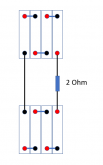After you get them to full charge and as close as you reasonably can in voltage, get a 10 watt, 2 ohm resistor and put that between them till they equalize in voltage. That will limit the current while they equalize.
View attachment 4980
This drawing is for 12 volt packs but it all works exactly the same.
Even if there is 2 full volts difference between the two batteries, the current is limited to 1 Amp. As the batteries equalize, the current will drop.
Note: Depending on how out of balance the two packs are, and how large the packs are, it could take a while to equalize. Just plan on leaving them overnight and then see if they have equalized.
If you don't have a 2 ohm resistor, use something larger. A 10 ohm 2 watt could work if your voltages are starting within a volt or less of each other. However, with a larger resistor, the time to equalize will be longer.



